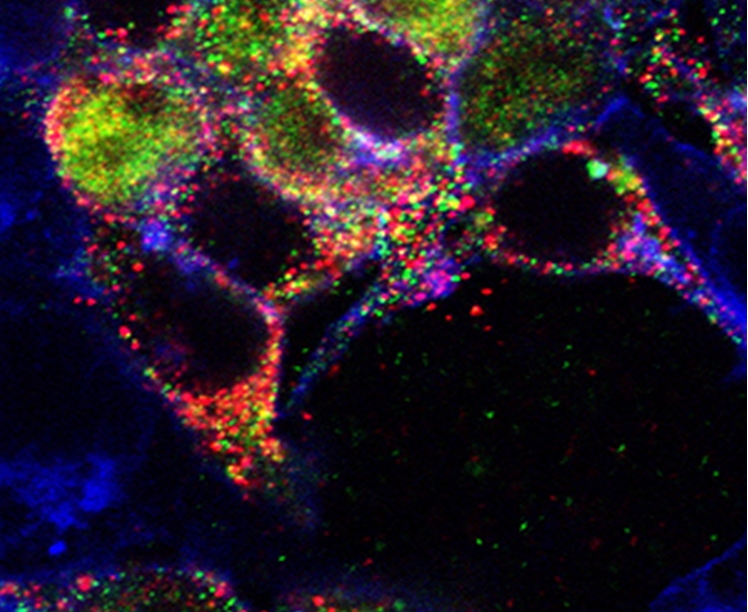Finding advances likelihood of using losartan for chronic emphysema and bronchitis, and other chronic obstructive pulmonary diseases
BALTIMORE, Maryland — Working with mice, scientists at Johns Hopkins have successfully used a commonly prescribed blood pressure medicine, losartan (Cozaar), to prevent almost all of the lung damage caused from two months of exposure to cigarette smoke. The treatment specifically targeted lung tissue breakdown, airway wall thickening, inflammation and lung over-expansion.
As a result of the experiments, efforts already are under way at Johns Hopkins for a clinical trial of the drug in people with smoking-related chronic obstructive pulmonary disease (COPD), the long-term consequence of smoking and for which, until now, there are no known potential treatments to prevent or repair the resulting lung damage. COPD is the third leading cause of death in the United States, mostly in people with either chronic bronchitis or emphysema, or both; some 12 million Americans have been diagnosed with COPD. Funding of the trial is from the National Heart, Lung and Blood Institute and the drug’s manufacturer, Merck & Co.
“The results of our study in mice suggest that losartan or similar drugs could serve as an effective treatment for smoking-related lung diseases in humans,” says study senior investigator for the animal experiments, Enid Neptune, M.D. “And because these drugs are already approved for use in the United States as safe and effective treatments for hypertension, incorporating them into our treatment regimen for COPD would be quite rapid,” adds Neptune, a pulmonologist and an associate professor at the Johns Hopkins University School of Medicine.
A report on the study, to be published in the Jan. 3 edition of theJournal of Clinical Investigation, is considered a breakthrough discovery, researchers say, because it is the first to show that a drug already in clinical use can prevent most the serious consequences of smoking in an animal test model, preserving both lung structure and function. The study is also believed to be one of the first to extend findings from research on other complex genetic conditions, specifically Marfan syndrome, for which losartan therapy is also being clinically tested, to probe how such treatments can be applied to other complex diseases that damage the lungs in a similar way.
In smoking-related COPD, breathing becomes difficult and progressively worsens, as the small airways and airspaces that conduct oxygen through the lungs and into the bloodstream become damaged. Airway walls thicken and are more readily obstructed by mucus, and the airspaces lose their elasticity.
“It is very exciting that an existing medication has proven capable in an animal model of not only treating the problems of COPD, but also disrupting the biological pathway that precipitated them,” says pulmonologist Robert A. Wise, M.D., a professor at Johns Hopkins who is piloting the clinical studies. “If our tests in people prove successful, we could help restore lung health to millions of people who have suffered from tobacco addiction.”
Wise says existing remedies for smoking-related COPD are few, and mainly consist of providing relief of symptoms, such as shortness of breath, coughing and mucus production. Drugs that lower blood pressure also help, and surgery can be done to remove damaged portions of the lung or transplant new lungs.
Neptune and Wise began their investigation of losartan after a colleague at Johns Hopkins, Harry (Hal) Dietz, M.D., discovered that the medication could potentially treat Marfan syndrome, which results from a single genetic mutation and weakens arteries, affecting all major organs, including the lungs.
The pulmonary researchers wanted to know if the medication, formally known as losartan potassium, had the same reparative effects on the lungs in other more complex, common and multigenic respiratory diseases, such as COPD.
Previous research on losartan, by Dietz and other researchers, had shown that the drug, part of a class of medications called angiotensin II receptor antagonists, blocked the action of a key signaling protein called transforming growth factor beta, or TGF-beta for short. Neptune’s own research showed that TGF-beta levels were elevated in lung tissue samples from smokers with COPD, as well as in the lung tissue of mice with Marfan syndrome.
Indeed, Neptune and Dietz’s foundational research in 2003 had shown that TGF-beta neutralizing antibodies prevented developmental emphysema in Marfan mice. But until now, Neptune says, no one knew if this biological pathway was simply a consequence of COPD or actually drove it. From a translational medicine standpoint, that bit of information was necessary to gauge losartan’s potential in treating the lung disease.
“Our research shows two distinct strategies to block TGF-beta prevent cigarette smoke-induced lung injury,” says Neptune. “This suggests that the TGF-beta biological pathway may be a major contributor to COPD disease progression.”
In the new set of experiments, the Johns Hopkins team first confirmed elevated levels of TGF-beta in the lungs of mice exposed to cigarette smoke and in lung tissue samples of eight smokers with COPD. Biochemical analyses showed that smoke-exposed mice had a fourfold increase in TGF-beta signaling in their lungs than mice exposed to indoor air only; in people, TGF-beta signaling in the COPD sufferers’ lungs was 25 percent greater than in those of nearly a dozen smokers without COPD. Human tissue samples came from the NHLBI’s National Lung Tissue Research Consortium.
While continuing exposure to tobacco smoke, some mice were treated with either a low-dose of losartan (0.6 grams per liter), or a high dose (1.2 grams per liter.) Another set of smoke-exposed mice was given a neutralizing antibody to TGF-beta signaling, the same treatment that had been used in Marfan mice.
Researchers found major improvements in more than a half-dozen measures of lung damage. Airway wall thickness had doubled from smoking in untreated mice, but was 50 percent less in those treated with either dose of losartan or with TGF-beta antibodies. Losartan-treated mice showed no signs of lung over-expansion and no signs of increased collagen deposition, a gauge of TGF-beta activity, and had normal levels of elastin-metabolizing enzymes and protein fragments in their air sac walls. Measures of oxidative stress, inflammation and cell death were also better in mice given the blood pressure medication.
Researchers say their next steps, beyond the pilot clinical trial, are further experiments on the role played by TGF-beta signaling in COPD and determining who best responds to anti-TGF-beta signaling treatments. Neptune says this approach represents an early step toward personalized or individually specific treatments for COPD sufferers.
“Understanding the basic genetic and molecular workings of a disease, in this case Marfan syndrome, has been the key to finding a drug that appears to address a contributing cause for a variety of diseases, including those triggered by such causes as smoking rather than faulty genes,” says Dietz, the Victor A. McKusick Professor of Genetics and Medicine at the McKusick-Nathans Institute of Genetic Medicine at Johns Hopkins. “The essence of translational medicine is to apply the lessons of basic science as broadly as possible to ease human suffering, and this new work advances that cause tremendously,” adds Dietz, who is also a Howard Hughes Medical Institute investigator.
Funding support for this study was provided by the NHLBI, a member of the National Institutes of Health, and by the Grace Anne Dorney fund for tobacco-related research.
Source:Johns Hopkins Medicine





